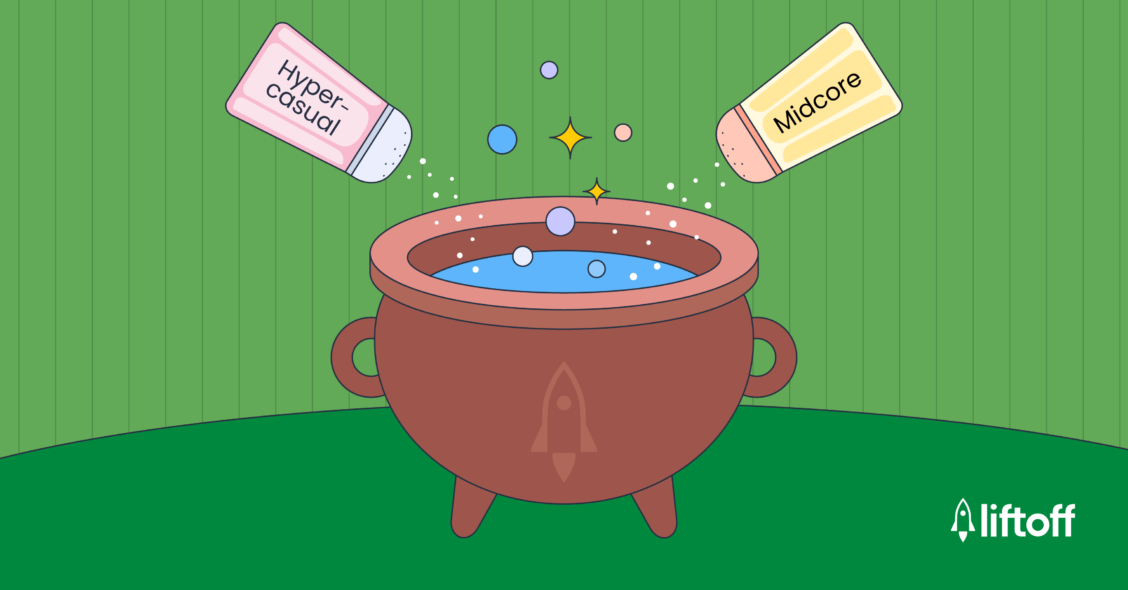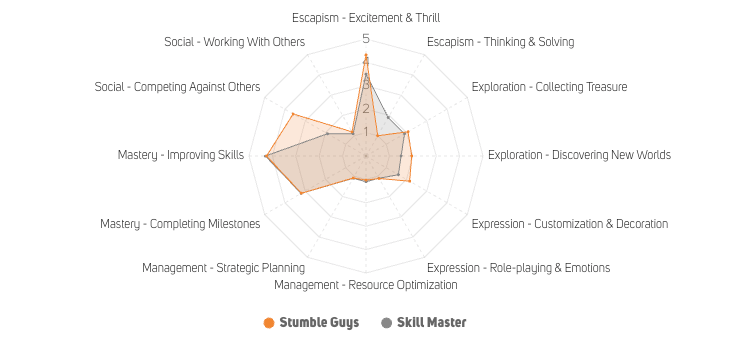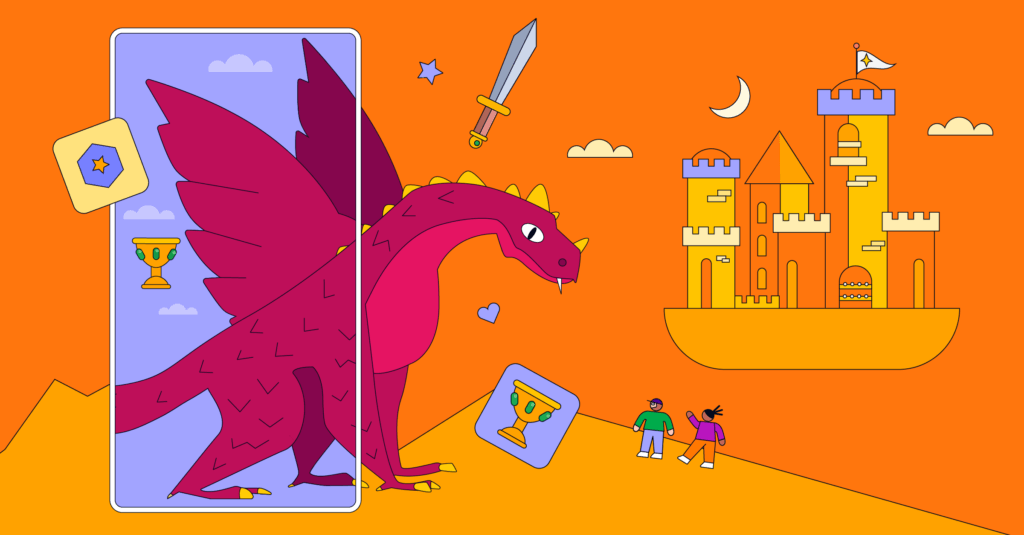
What the Rise of Hybrid-Casual Games Means for Advertisers
For years, hyper-casual was the go-to genre for many mobile game developers and marketers. With simple interfaces and easy-to-understand gameplay mechanics, hyper-casual titles—such as Helix Jump, Jelly Shift, and Flappy Bird (the OG hyper-casual game)—appealed to players of different ages and demographics.
The popularity of hyper-casual games, however, is starting to wane. New privacy regulations have made user acquisition (UA) more challenging for hyper-casual games, which were already battling to stand out in an increasingly saturated market. The already-narrow profit margins for the genre continued to fall as market interest rates rose, and the genre saw a 20% fall in install share.
To survive in a changing market, many hyper-casual games are incorporating deeper gameplay mechanics from midcore games to widen their appeal, resulting in the rise of a new genre known as “hybrid-casual.” As these hybrid games continue to grow, mobile marketers may be wondering where to invest their ad spend and how to showcase the new genre in impactful ad creative.
What are hybrid-casual games?
Hybrid-casual games combine elements of the hyper-casual genre with more complex gameplay mechanics from the midcore genre. Anyone can enjoy hybrid-casual games, but they have more depth to the gameplay mechanics, meaning they can engage players for longer. Hybrid-casual games are now one of the most successful examples of hybridization, with over five billion downloads last year.
A good example is Archero by Habby. Its core gameplay only has two controls, move and shoot, but it offers players depth through additional RPG meta layers that enable character and weapon upgrades. This mix appeals to a broader audience, but the gameplay has enough depth to encourage users to stick around.
Hybrid-casual games are also part of a larger trend of hybridization. Mobile games from various genres have been integrating elements from other genres into their games to boost player engagement—usually in the form of simple minigames that differ from core gameplay. For example, the idle RPG character collector X-Hero introduced a minigame called “SaveDoge,” where players draw a protective barrier around an image of a dog. It even built a playable ad around these mechanics, which helped to launch itself to the top of the US iOS download charts.
How hybrid-casual games tap into player motivations
Hybrid-casual games, and hybridization more generally, have proven successful because varied gameplay mechanics appeal to the motivations of a broad range of players rather than a select few. By motivations, we mean why a user is attracted to a specific type of game. GameRefinery’s Motivational Driver Framework makes this easier to understand by breaking down mobile gamers across the market into eight distinct archetypes comprising 12 motivational drivers.
For example, a user that falls into the “King of the Hill” player archetype enjoys playing games that offer a high degree of competition with other players, such as Roblox or Fortnite. Meanwhile, a “Thrill Seeker” user wants to experience an adrenaline rush and prefers games that demand fast reaction times, such as in the racing genre. There are also “Skill Master” users who want to improve and enjoy being challenged—qualities often found in RPG games.
If you apply this framework to a hybrid-casual game, such as Stumble Guys, you can see how a wide range of motivations come into play. This popular game is built around a simple hyper-casual racing core, where players rush to the finish line across different courses to unlock rewards and beat various challenges. It also incorporates first-person shooter and platforming elements through additional gameplay modes. This combination appeals to the Thrill Seeker, the King of the Hill, and the Skill Master simultaneously.

Why hybrid elements in UA can improve acquisition
The broad appeal of hybrid-casual games can be a boon for mobile marketers. By highlighting hybrid elements within playable ads, advertisers can tap into new audiences who might not otherwise have been interested—boosting user acquisition.
Take Voodoo’s Mob Control as an example. This hybrid-casual game features a tactical-battler core that lets players attack other players’ bases by steering cannons that launch mobs onto enemies and multiplier gates (a trending hyper-casual mechanic). It combines this with a character card-collecting meta focusing on mob, cannon, and champion card collecting and upgrading (RPG upgrade elements).
This blend provides Mob Control with two different options for its ads. By highlighting its RPG elements, the game can appeal to more experienced gamers while showcasing its hyper-casual features enabling it to maintain its more mainstream appeal. Just remember that ad playables need to be a realistic representation of the game they’re promoting, or newly acquired users may end up deleting it further down the road.
Which genres are the most effective to hybridize?
According to our Casual Games Report, ads in hyper-casual games still drive the most installs at 32.3%, despite the genre’s decline in popularity. Next is puzzle at 31.3%, followed by simulation and lifestyle games, each at around 9%. If you’re unsure which genre fits your game, these four casual game genres aren’t a bad place to start.
The report also found that mobile game ads displayed in other titles from the same (or similar) genres typically drove the most installs because these fulfilled similar motivational drivers for players. For example, the biggest install drivers for match 3 games were ads in other puzzle games (43.9%). However, there was also a significant crossover with surprising subgenres such as word (11.2%) and lifestyle (13.1%) games.
For hybrid games, the findings suggest that experimenting with ad placements in diverse genres could lead to big wins. By promoting their hybrid playables in these areas, mobile marketers can boost their user acquisition further and maximize the return on their ad spend.
Key things to consider
Hybrid-casual games offer plenty of opportunities for mobile marketers to improve the effectiveness of their ad campaigns, from widening their potential demographic to paving the way for increased experimentation. But to be successful, there are a few key things advertisers need to consider before jumping on the trend:
- Ensure that your hybrid playables authentically represent your mobile game, or you risk alienating newly acquired players once they begin to play your title.
- Don’t limit your target audience to one type of player. Create a motivational profile based on what you know about your players, and use this to guide the creative direction of your ads.
- The same rules apply when building hybrid playables as when crafting any other—they should captivate your audience and showcase the best aspects of your game while keeping things simple.

